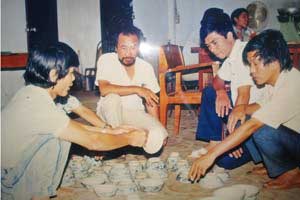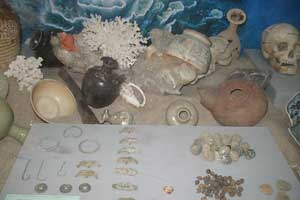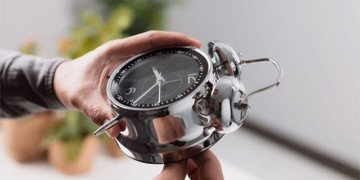A collection of artifacts recovered from 10 shipwrecks has been introduced by the Department of Culture and Information of Ba Ria – Vung Tau and the Vietnam History Museum under the theme “Artifacts from the Depths of the Vietnamese Sea“. According to scientists, these artifacts are living evidence that document historical, cultural, and economic events of various eras.
 |
|
Experts evaluating artifacts from the ancient shipwreck at Hon Cau. (Photo from the exhibition) |
According to scientists, the collection of artifacts also represents artistic creations and craftsmanship from centuries past.
Among these are artifacts from the ancient shipwreck at Hon Cau (Coordinates X), artifacts excavated from the waters off Hon Ba (Vung Tau), porcelain from the Yongzheng period of the Qing Dynasty, and collections from the ancient ships at Hon Chau, Hon Dam, Ca Mau, Binh Thuan… These artifacts vividly portray a portion of Vietnam’s past, reflecting the cultural, technical, and artistic achievements of the time.
The marine artifact collection comprises tens of thousands of items, showcasing a variety of forms produced in Vietnam, China, Thailand, and more, highlighting the significance of Vietnam and Ba Ria – Vung Tau’s maritime industry in global trade routes prior to the 19th century.
 |
|
Artifacts from the ancient shipwreck at Cu Lao Cham, 15th century. Photo: D.V. |
The story of excavating ancient ships in the waters of Vietnam is quite fascinating. For instance, in early 1997, a fisherman specializing in diving for scrap metal discovered a shipwreck approximately 4 nautical miles west of Bai Dau Beach, Vung Tau. Divers retrieved 105 artifacts, including ceramics, crystal, glass, and bronze items. The collection of white glazed pottery mostly consists of original pieces, with some dishes inscribed with the mark De Ploe – Paris, suggesting a possible production location, while others bear the imprint E.Biedermann&Co – Saigon, indicating that the goods on board were ordered from this company in Saigon around the mid-19th century.
Notably, the collection from the ancient shipwreck at Cu Lao Cham was obtained through the most extensive and scientifically conducted excavation in history, utilizing advanced equipment. Numerous scientists from both domestic and international backgrounds participated, with funding reaching up to 6 million USD, officially excavating from 1997 to 2000 in the waters off Hoi An, Quang Nam.
On this ancient ship, the museum currently holds a total of 240,000 artifacts, including products from the Chu Dau pottery kiln in Hai Duong; items used by the crew made of ceramics and earthenware; and many coins dating back to the Kaiyuan period (Tang Dynasty) and Hongwu period (Ming Dynasty). For the first time in underwater archaeological excavations, the remains of the crew were also discovered, including 11 individuals, one of whom was a woman over 20 years old, belonging to the Thai ethnic group…
The exhibition of artifacts will run until April 16 at the Youth Cultural Center in Vung Tau City.
A.V.

















































